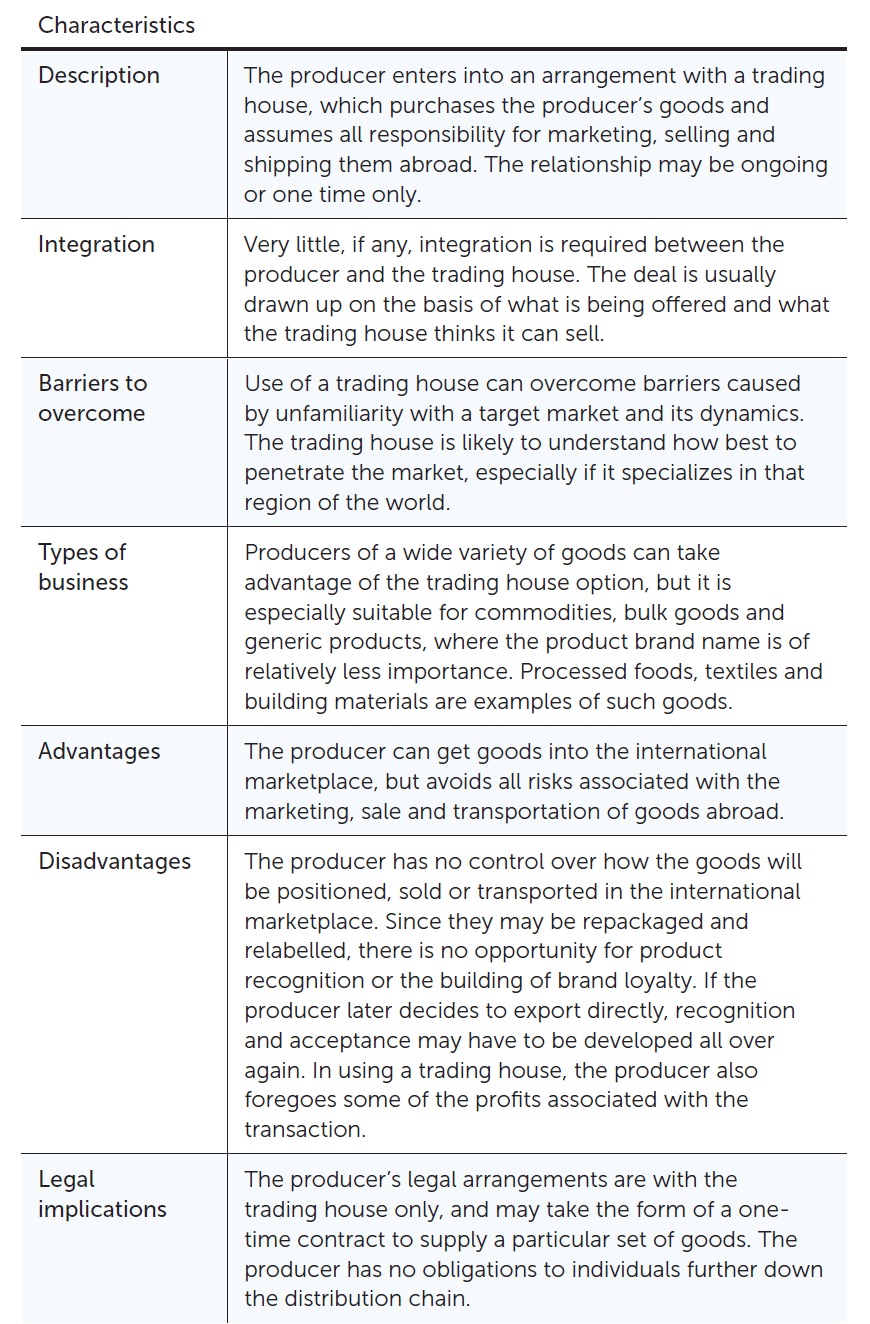
Indirect exporting is often an easier market entry strategy to implement than direct exporting, especially for small and medium-sized businesses.
Indirect exporting is the other trading market entry strategy an organization may choose, and requires fewer dedicated resources than direct exporting. In indirect exporting, organizations sell to an intermediary in their own country. This intermediary then sells the goods to the international market and takes on the responsibility of organizing paperwork, permits, shipping and marketing.
By using an intermediary, the organization avoids various types of risk, including currency risk. There are several intermediaries that may be used in indirect exporting, including trading houses and confirming houses.
Trading houses
Trading houses are firms that buy goods from manufacturers specifically to export them. They have a long history, with the first established in Italy about seven hundred years ago. As they developed, they prompted worldwide exploration and trade.
The Hudson’s Bay Company was one of the trading houses responsible for the fur trade that opened up Canada to European exploration and settlement. The East India Company, another trading house, played a pivotal role in establishing British rule in India and was instrumental in opening British trade with China. Foreign firms controlled Japan’s export trade for many years until Japanese trading organizations, such as Mitsui and Sumitomo, expanded and began to control their own country’s trade.
There are hundreds of trading houses worldwide and organizations can work with them for numerous market entry strategies, although they are most likely to be used for indirect exporting. Other ways in which trading organizations can act in a market entry strategy include the following:
- Providing investment funds through their merchant banking operations
- Acting as a foreign buyer for direct exporters
- Becoming a licensee or franchisee
- Becoming a joint venture partner
By using the services of a trading house, organizations relinquish title to the goods they are exporting before they leave the country, and the trading house assumes all responsibility for selling and shipping the goods. This has both positive and negative implications for the manufacturing organization.
On the positive side, the trading house assumes all the risks and costs of finding foreign buyers and delivering the goods to them. The producer is assured of payment when the trading house signs the contract, and does not need to be concerned with anything else regarding the export transaction. Many trading houses specialize in specific types of goods (such as processed foods, electronic parts, or clothing and textiles) or they have developed expertise in certain parts of the world. This means they might be able to find a broader market for the goods they sell or get a better price than the producer would.
On the negative side, the manufacturing organization has no control or influence over how the product will be positioned, marketed, priced and delivered. Therefore, the trading house option is not suitable for organizations interested in establishing a reputation for their products in a foreign country or in developing market share abroad. The trading house is within its rights to sell the products to foreign buyers who may repackage and relabel them to the point where they can no longer be identified as the producer’s.
Indirect Exporting Through Trading Houses
Want to learn more about how to decide whether a direct or indirect strategy will work best for you? Check out the FITTskills Implementation of Market Entry Strategies online workshop!
Confirming houses
Confirming houses or buying agents represent foreign firms that want to purchase products or services. They seek to obtain the desired items at the lowest possible price and are paid a commission by their foreign clients. In some cases, they may be foreign government agencies or quasi-governmental firms empowered to locate and purchase desired goods. An example is a foreign government purchasing mission.
A good place to find these agents is through foreign government embassies and embassy websites.
Finding and choosing the best indirect intermediary for your business
In many cases, an interested intermediary will contact the organization. If an organization wants to move into indirect exporting, it can find intermediaries using the following strategies:
- Search exporter’s associations
- Contact chambers of commerce and trade associations
- Contact foreign embassies and trade commissioners in target markets
- Access commercial databases of organizations operating in target markets
- Participate in international expos and trade shows
Organizations reflect on their situational analysis and risk analysis when deciding what type of intermediary they will pursue. Their choice will depend upon the type of product or service they offer and the target markets they are trying to reach.
Regardless of the type of intermediary, organizations must identify their own goals and perform due diligence before choosing a particular intermediary. They should outline the specific selection criteria to be used in the selection process. A commercial risk analysis should be completed on any potential intermediary.
Next steps in your indirect exporting process
In some cases, there are programs and services organizations can access to assist them with their indirect exporting goals. Government and non-governmental programs may provide organizations with financial support. As indirect exporting does not require any complicated financial risk, most organizations will approach their local financial institution if they require additional resources for launching an international initiative.
As with any new venture, organizations must make sure they are prepared to implement the required processes and meet the new requirements. For indirect exporting, organizations must ensure they can meet contractual requirements related to quantity and quality, such as products being compliant and properly labelled. The intermediary may also require documentation that is new to the organization.
Some organizations will always use indirect exporting as their only market entry strategy. For others, indirect exporting can be a first step to developing competence and confidence in international trade. As this competence and confidence grows, organizations may consider using multiple channels of market entry to achieve their goals.







disqus comments